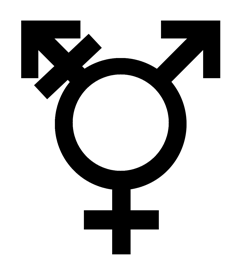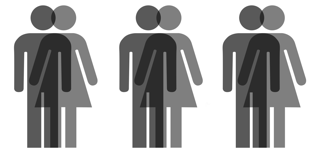Despite gender neutrality entering the mainstream in several ways lately with the increased popularity of gender-neutral bathrooms, clothing, and pronouns, there are still common misunderstandings about non-binary genders.
The Charlatan dives into non-traditional gender identities, the significance of using the right pronouns, and the detrimental effects misgendering has on non-binary individuals.
But first, what are gender-neutral pronouns?
“Gender-neutral pronouns are pronouns that aren’t associated with [the] male or female gender,” said Lukayo Estrella, OPIRG-Carleton’s Outreach and Programming Coordinator.
Otherwise known as non-binary pronouns, Estrella said they are the preferred way to identify folks on the non-binary spectrum—including transgender, genderqueer, and agender individuals.
For Laura Klein, a second-year Carleton linguistics student who prefers “they/them” pronouns, these non-binary pronouns are part of their identity.
“I first realized I was gender fluid about a year ago after a lot of questioning and self reflection,” Klein said via Facebook. “At first I wanted to use ‘vae/vaer’ pronouns, but I finally decided that I liked ‘they’ best for ease of use.”
According to the University of Wisconsin-Madison’s LGBT Campus Center website, ‘they/them’ pronouns are most popular, but invented pronouns like ‘vae/var’ and ‘ze/hir’ may better fit one’s gender identity.
Val Williamson, a second-year University of Toronto student who uses “they/them” or “he/him” pronouns, said they found their preferred pronouns after researching non-binary gender identities.
“I thought it was something that I might identify as,” Williamson said via Facebook. “I liked ‘they/them’ pronouns because they just fit me, it was like finding my niche outside of binary genders.”
The history around these pronouns
Research shows that gender-neutral pronouns are not a new phenomenon.
Dennis Baron, an English and linguistics professor at the University of Illinois, said in his research essay “Pronoun Showdown” that English language pronouns have been extensively changed and debated for hundreds of years.
“Thon and he’er, perhaps the most popular—and they were never really popular—appeared in Webster’s New International Dictionary . . . But they were eventually dropped because not enough people used them,” Baron stated in his research essay.
“Invented pronouns have yet to catch on, but still, people keep on trying, which suggests there’s a need for them,” he added. “The problem is, not enough people are paying attention to these new words.”
Estrella said non-binary individuals have always existed, too.
“We’ve always been here,” they said, speaking of non-binary folk. “Through war, through oppression, our voices and lives have been wiped out, and the pronoun thing is just one small simple thing in a huge frontline of things we’re trying to do to make sure that we are safe and we are recognized.”
Three steps to using gender-neutral pronouns
“Using one’s correct pronouns is basic respect,” Klein said, adding it’s important for people to be educated on how to use them.
Here are three handy guidelines on using gender-neutral pronouns:
- Just ask, but don’t interrogate
“It takes two seconds to ask someone’s pronouns,” Williamson said.
But asking someone for their pronouns doesn’t entitle one to a full-fledged Q&A as Ty Jardine, a second-year Carleton women’s and gender studies and anthropology student, who prefers “they/them” pronouns, said they often experienced.
Jardine said they are often questioned after informing someone about their pronouns.
“[I end up] having to explain what genderqueer is and that ‘they’ is allowed to be used as singular in English,” Jardine said via Facebook.
Jardine added they have also been pressed to “explain some of the more scientific facts about being transgender and gender identity as a social construct.”
- Don’t assume
Williamson said people frequently make split-second judgements about one’s preferred gender identity and pronouns.
“I get misgendered very often; I am a transgender man, but I don’t pass as a guy so it’s a daily occurrence that I get misgendered and seen as a cis woman,” they said. “It makes me feel invalidated and disrespected as a transgender person when someone misgenders me or makes assumptions about my gender.”
Klein said when they are misgendered, they have to decide whether or not to correct the individual.
“In general people seem to not want to learn. I try not to engage with strangers or acquaintances, because I feel it’s not worth the argument,” Klein said.
- Be respectful
Estrella said lack of care for one’s preferred pronouns can be deeply disrespectful.
“There have been different kinds of Indigenous and non-western cultures that have up to eleven genders that are based on your spiritual and cultural role,” they said. “So for people to not want to use gender-neutral pronouns is also a racist act because they refuse to acknowledge that other cultures have more than two genders, and that they are valid.”
Jardine added it’s important to respect others’ identities by correcting your slip-ups.
“People will immediately correct themselves if they misgender a pet, so they can do it for a human who actually has an understanding and experience of gender,” Jardine said.
Williamson said people are sometimes unhappy to use one’s preferred pronouns because they don’t understand their situation.
“When people don’t understand the importance of pronouns, I try to use an example of a situation that might be more relatable,” they said. “For example, if someone is calling you by a different name, even though you’re constantly correcting them, it gets very frustrating and disrespectful after a while.”
“Now replace name[s] with pronouns and that’s an inkling of what a lot of trans people go through on a daily basis.”
Klein added that using preferred pronouns correctly shows trans and gender nonconforming individuals they are valued and respected as human beings.
They said not using their prefered pronouns makes them feel insulted, like anyone referred to by a wrong name or unwanted nickname would be.
“If you can’t refer to someone as they wish to be referred to, then I don’t want your company, and [that] would be true even if I weren’t gender nonconforming,” Klein said.







